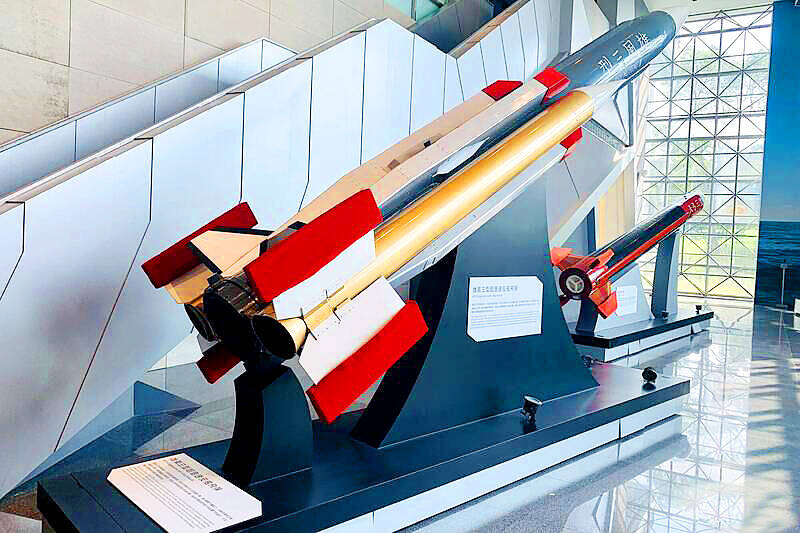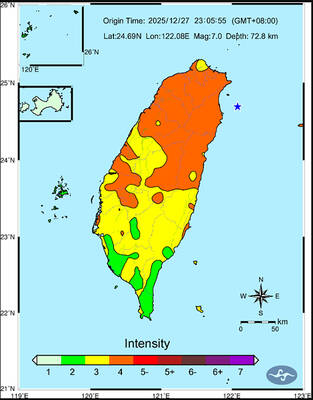The Ministry of National Defense plans to develop supersonic combustion ramjet, or scramjet, technology linked to hypersonic missile systems, a solicitation notice issued by the ministry for next year’s National Defense Advanced Research Program said.
The Chungshan Insitute of Science and Technology would oversee the program to create a heat-resistant composite ceramic material and improve scramjet engine ignition and flame retention, the ministry said in a notice issued to Taiwanese universities in June.
This program — scheduled to be implemented over three years — revolves around materials and technologies underlying scramjet engine performance.

Photo: Chen Chih-cheng, Taipei Times
Hypersonic systems are superior to conventional ballistic missiles with regard to deterrence value, as their speed, altitude and maneuver-in-flight capabilities give the target little time to implement countermeasures or retaliatory strikes.
The scramjet program is evidence that the armed forces likely plan to obtain a type of long-range system capable of deterring China.
Chungshan Institute of Science and Technology adviser Su Yu-pen (蘇玉本) earlier this month said that materials science and thermal design would be crucial in the nation’s bid to develop hypersonic technology.
Taiwan has no lack of resources or expertise in other fields relevant to hypersonic weapon systems, he said.
Separately, the government has issued an airspace closure notice, as the air force is to conduct fighter exercises using live munitions over the ocean to the east of Taiwan from Aug. 27 to Sept. 12.
The air-to-air missile drills would involve F-16 jets armed with AIM-120 and AIM-9X missiles, Mirage 2000 jets armed with the MICA and R.550 Magic missiles, and AIDC-F-CK-1 jets armed with Tien Chien II missiles, a defense official said, speaking on condition of anonymity.
The navy is also holding large-scale weapons exercises in waters east of Taitung and Pingtung County, west of Green Island (綠島) and Orchid Island (Lanyu, 蘭嶼), and south of Orchid Island and Pingtung, government notices have said.
The drills, which likely involve the use of surface-to-air and anti-ship missiles by warships, are to be held until the end of this month, they said.
The large size and unlimited altitude of the exercises imply that a sinking exercise could be included in the drills, sources said.
Last week, the army began conducting “maintenance fire” artillery drills, replacing the live-fire component that used to be included in the annual Han Kuang military exercises.
The Eighth Army Corps and marine units are expected to begin live-fire TOW missile exercises later this month.

A magnitude 7.0 earthquake struck off Yilan at 11:05pm yesterday, the Central Weather Administration (CWA) said. The epicenter was located at sea, about 32.3km east of Yilan County Hall, at a depth of 72.8km, CWA data showed There were no immediate reports of damage. The intensity of the quake, which gauges the actual effect of a seismic event, measured 4 in Yilan County area on Taiwan’s seven-tier intensity scale, the data showed. It measured 4 in other parts of eastern, northern and central Taiwan as well as Tainan, and 3 in Kaohsiung and Pingtung County, and 2 in Lienchiang and Penghu counties and 1

FOREIGN INTERFERENCE: Beijing would likely intensify public opinion warfare in next year’s local elections to prevent Lai from getting re-elected, the ‘Yomiuri Shimbun’ said Internal documents from a Chinese artificial intelligence (AI) company indicated that China has been using the technology to intervene in foreign elections, including propaganda targeting Taiwan’s local elections next year and presidential elections in 2028, a Japanese newspaper reported yesterday. The Institute of National Security of Vanderbilt University obtained nearly 400 pages of documents from GoLaxy, a company with ties to the Chinese government, and found evidence that it had apparently deployed sophisticated, AI-driven propaganda campaigns in Hong Kong and Taiwan to shape public opinion, the Yomiuri Shimbun reported. GoLaxy provides insights, situation analysis and public opinion-shaping technology by conducting network surveillance

‘POLITICAL GAME’: DPP lawmakers said the motion would not meet the legislative threshold needed, and accused the KMT and the TPP of trivializing the Constitution The Legislative Yuan yesterday approved a motion to initiate impeachment proceedings against President William Lai (賴清德), saying he had undermined Taiwan’s constitutional order and democracy. The motion was approved 61-50 by lawmakers from the main opposition Chinese Nationalist Party (KMT) and the smaller Taiwan People’s Party (TPP), who together hold a legislative majority. Under the motion, a roll call vote for impeachment would be held on May 19 next year, after various hearings are held and Lai is given the chance to defend himself. The move came after Lai on Monday last week did not promulgate an amendment passed by the legislature that

AFTERMATH: The Taipei City Government said it received 39 minor incident reports including gas leaks, water leaks and outages, and a damaged traffic signal A magnitude 7.0 earthquake struck off Taiwan’s northeastern coast late on Saturday, producing only two major aftershocks as of yesterday noon, the Central Weather Administration (CWA) said. The limited aftershocks contrast with last year’s major earthquake in Hualien County, as Saturday’s earthquake occurred at a greater depth in a subduction zone. Saturday’s earthquake struck at 11:05pm, with its hypocenter about 32.3km east of Yilan County Hall, at a depth of 72.8km. Shaking was felt in 17 administrative regions north of Tainan and in eastern Taiwan, reaching intensity level 4 on Taiwan’s seven-tier seismic scale, the CWA said. In Hualien, the